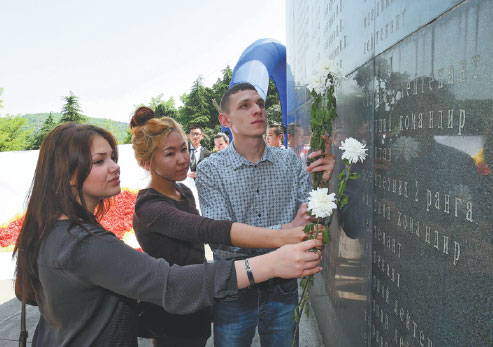Nanjing honors heroes of 'Hump Airlift'
 0 Comment(s)
0 Comment(s) Print
Print E-mail China Daily, August 3, 2015
E-mail China Daily, August 3, 2015
 |
|
Russian students pay tribute to heroes from the former Soviet Union who died when assisting China against Japanese aggression in WWII. Photo by Sun Can / Xinhua |
Liao Yongbao was 64 years old before he learned the where-abouts of his father's grave. That was in 2004, when Liao, now 75, first saw his father's name engraved on a black marble tablet.
Liao Jingcheng, who was killed in aerial combat on June 18, 1941, when his son was just 10 months old, is buried at the Nanjing Anti-Japanese Aviation Memorial Hall, a complex in Zhongshan, one of the most picturesque areas of the capital of Jiangsu province, surrounded by trees and bathed in melodious bird-song.
"After years of searching I finally found my father in the memorial hall," Liao said. "Tears streamed down my face as I read his name and the details of his life on the marble slab. I began to learn more about him when the workers sent me material related to him," he said.
"In 2009, the Jiangsu province government officially honored my father as a revolutionary martyr. Although I never had the chance to grow up with him, he will always be my hero."
The memorial hall holds the remains of 3,305 martyrs from the Japanese occupation of China: 2,197 of the dead were from the United States, 236 came from the former Soviet Union, and two were Korean nationals. The other 870 were Chinese.
The martyrs' cemetery, built by the government of the Republic of China, tells the story of how airmen from China, the US and the Soviet Union fought side by side against the Japanese.
The graveyard was badly damaged in the late 1960s, but in 1987 work began to restore it to its original glory, and construction of the memorial - 30 black marble tablets engraved with the names of the fallen in Chinese, English and Russian - was completed in 1995. A memorial plaza was added a short time later.
In 2008, the Nanjing government invested 40 million yuan ($6.4 million) to renovate and expand the hall, which was officially opened to the public in 2009.
Help from overseas
"The heroes sacrificed their lives in the battle against the Japanese aggressors, which was also part of the global war against fascism," said Luo Chaojun, deputy curator of the memorial hall. "Every year, more than 100,000 people visit to pay tribute to them. Their contribution to the country will never be forgotten.
"In the autumn of 1937, the Soviet Union government sent 1,091 aviators and technical experts to aid China's fight against Japan," he said.
"Before they returned to the Soviet Union in 1941, they had taken part in more than 50 battles in several major cities, and managed to shoot down 81 Japanese aircraft and blow up 114 aircraft and 14 ships."
According to Sun Yao, a guide at the hall, in the early years of the Pacific war, all aid from the US came in the form of private donations from individuals, but following the Japanese attack on Pearl Harbor in 1941, the US government officially began providing aid too.
"The Soviet Union was the first country to offer help to China, but the US played a crucial role in the latter half of the war against the Japanese," Sun said, adding that US aviators destroyed more than 2,600 Japanese aircraft and 44 ships, and killed or wounded more than 66,700 soldiers.
It's appropriate that the hall is currently hosting an exhibition about the "Hump Airlift", the longest, largest and most dangerous strategic airlift of World War II.
The operation, which began in 1942 and continued daily until 1945, saw military supplies, fuel, food and clothing transported over some of the most dangerous airspace in the world, from Assam in northeastern India to Kunming, the capital of Yunnan province. The routes - one north and one south - were China's only lifelines with the outside world once the Japanese had closed all the sea and overland routes into the country.
The planes left Dinjan airfield in Assam and headed east to cross the Himalayas, the Gaoligong Mountains, the Hengduan Mountains and several major rivers before finally arriving at Kunming. The route got its nickname because the aircrews thought the rolling mountains resembled camels' humps.
For the pilots, the flights required endurance, supreme flying skills and bravery. At an average height of 4,500 to 5,500 meters, the terrain over which the aircrews flew is some of the highest in the world, reaching 7,000 meters at its highest point. Moreover, the local microclimate results in thick fog, violent thunder-storms and strong winds.
According to Sun, China National Aviation Corp, which was jointly owned by the Chinese government and Pan American Airways, and the US Army Air Force Air Transport Command combined to undertake the airlift and transport large quantities of supplies to China. CNAC was the perfect partner, having already undertaken many military transport flights between 1938 and 1941.






Go to Forum >>0 Comment(s)